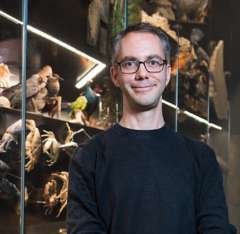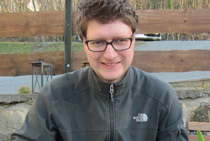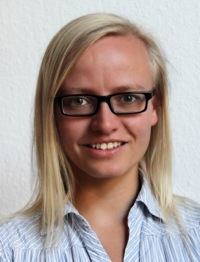
Head

My main research interest is to understand the distribution of life on earth (e.g. species, biodiversity, vegetation types, ecosystems) through space and time. I am particularly interested in interactions between climate and the terrestrial biosphere. This includes potential impacts of climate change on species, ecosystems and associated ecosystem services, as well as the role of the biosphere in the earth climate system (e.g. carbon and water cycling). Methodologically, vegetation and ecosystem modelling at local to global scales has been at the core of my work.
Examples of current projects:
- GEOEssential
- EarthShape: Earth Surface Shaping by Biota
- Ecosystem Management Support for Climate Change in Southern Africa (EMSAfrica)
- The open Climate Impacts Encyclopedia (ISIpedia)
- Past warm periods as natural analogues of our “high CO2” climate future (VeWA Project)
- Environmental changes in biodiversity hotspot ecosystems of South Ecuador: RESPonse and feedback effECTs (FOR2730)
- Fire in the Future: Interactions with Ecosystems and Society – FURNACES
- Multisectoral analysis of climate and land use change impacts on pollinators, plant diversity and crops yields – MAPPY
- BioDiv-Support: Scenario-based decision support for policy planning and adaptation to future changes in biodiversity and ecosystem services
Examples of environmental impact assessments:
- IPBES-IPCC Co-Sponsored Workshop Report on Biodiversity and Climate Change
- Global Assessment Report on Biodiversity and Ecosystem Services (Chapter 5)
- IPBES Scenarios and Models Assessment
- North Sea Region Climate Change Assessment (NOSCCA, chapter Terrestrial Ecosystems)
BSc. and MSc. topics (‘Abschlussarbeiten’)
For international publications and peer-reviewed published papers, see my profile on Google Scholar or my Web of Science Researcher ID S-6287-2016
For further publications, e.g. IPBES assessments, see Further publications (pdf)

RESEARCH INTERESTS
I am an Ecologist by training, deeply interested in understanding how environment and ecosystems work, and profoundly convinced that mathematics and modelling are the way to reach that knowledge. My primary research interest is in the area of modelling forest ecosystem functioning, with particular focus on Carbon cycle and forest productivity in alpine and mountain ecosystems, bringing together critical issues such as air pollution, land use and grazing, as well as their impact on carbon stock, habitat composition, and ultimately biodiversity in high-elevation ecosystems, which are particularly affected by climate change.
My main research topic focuses on the design, construction and application of mathematical models to estimate and predict rates of biosphere–atmosphere trace gas exchange, species distribution, and vegetation dynamics such as productivity and growth. Given the rising importance of statistically sound estimates of uncertainties in order to obtain reliable model predictions, I focused most of my modelling activity on Bayesian model calibration to calculate both parameter and predictive uncertainties, and I worked extensively with model-data fusion techniques involving large datasets.
CURRENT PROJECTS
BioDiv-Support – The aim of this BiodivERsA-funded project is to develop future scenarios of biodiversity and ecosystem services for decision-makers and other end users to enable enlightened decisions for adaptation and policy on local and regional scales. The project focuses on changes to vegetation, including for example changes to the forest and tree line, and on the impact on vegetation of grazing and pollution (specifically Ozone and Nitrogen), as well as other indicators and services (https://www.biodiversa.org/1429).
rLPJGUESS – An R package facilitating sensitivity analysis, calibration and forward simulations with the LPJ-GUESS dynamic vegetation model (https://github.com/biometry/rLPJGUESS).
Dormann, C.F., Bagnara, M., Boch, S., Hinderling, J., Janeiro-Otero, A., Schäfer, D., Schall, P., and Hartig, F. (2020). Plant species richness increases with light availability, but not variability, in temperate forests understorey. BMC Ecology 20, 43 (2020). https://doi.org/10.1186/s12898-020-00311-9.
Bagnara, M., Silveyra Gonzalez, R., Reifenberg, S., Steinkamp, J., Hickler, T., Werner, C., Dormann, C.F., and Hartig, F. (2019). An R package facilitating sensitivity analysis, calibration and forward simulations with the LPJ-GUESS dynamic vegetation model. Environmental Modelling and Software, 111, 55–60.
Bagnara, M.,, Van Oijen, M. , Cameron, D., Gianelle, D., Magnani, F., and Sottocornola, M. (2018). Bayesian calibration of simple forest models with multiplicative mathematical structure: A case study with two Light Use Efficiency models in an alpine forest. Ecological Modelling, 371, 90–100.
Pullens, J.W.M., Bagnara, M., Silveyra Gonzalez, R., Gianelle, D., Sottocornola, M., Heijmans, M.M.P.D., Kiely, G., and Hartig, F. (2017) The NUCOMBog R package for simulating vegetation, water, carbon and nitrogen dynamics in peatlands. Ecological Informatics, 40, 35-39.
Bagnara, M., Sottocornola, M., Cescatti, A., Minerbi, S., Montagnani, L., Gianelle, D., and Magnani, F. (2015). Bayesian optimization of a light use efficiency model for the estimation of daily gross primary productivity in a range of Italian forest ecosystems. Ecological Modelling, 306, 57-66.
Bagnara, M., Van Oijen, M. , Cameron, D., Gianelle, D., Magnani, F., and Sottocornola, M. (2014). A user-friendly forest model with a multiplicative mathematical structure: a Bayesian approach to calibration. Geosci. Model Dev. Discuss., 7, 6997-7031.

RESEARCH INTERESTS
My work is focused on understanding the dynamics of tropical forests, its natural spatial and temporal patterns, and its response to anthropogenic pressures. In order to embrace its complexity, I use forest modelling and remote sensing as tools for tropical forest research, ultimately aiming for future applications in order to halt biodiversity loss in a future with strong human tropical presence.
I have a Bachelor’s degree in Environmental Sciences (2006), Master’s degree in plant ecology (2009) in Pernambuco Federal University and PhD (2017) in Ecological Modelling from the University of Osnabrück. I have experience in the field of ecology, with emphasis in forest ecology; ecological modelling, with focus on forest dynamics of fragmented landscapes and geographical information systems, climate change with focus on the carbon and hydrology cycles.
Keywords
Forest modelling, Animal-plant interactions, Forest fragmentation, Remote sensing, Carbon and hydrological cycles
CURRENT PROJECTS
- Environmental changes in biodiversity hotspot ecosystems of South Ecuador: RESPonse and feedback effECTs (RESPECT)
RESPECT aims to unveil how major ecosystem functions, (i) ecosystem biomass production, and (ii) water fluxes, are affected by ongoing and future environmental changes through alterations in response and effect traits of relevant biota for the mountain rain forest in South Ecuador. This question is addressed through the synergy of field and modelling studies, for which I carry out the development. The model also seeks to address questions of climate change and anthropogenic nutrient deposition in tropical mountain forests to ecosystem function and biodiversity loss along an elevational gradient.
The model in development for this project is the LPJ-GUESS-HUMBOLDT model, which includes implementation for the topics:
- Trait diversity
As opposed to the plant functional type approach, in which few representative species are simulated, the use of dynamic traits allows the plant community to adapt through ecological filtering to local simulated conditions. This allows for more adaptive simulations in which functional biodiversity can be represented and its value tested.
- Carbon, Nitrogen, Phosphorus soil-vegetation dynamics
The role of soil organic matter dynamics in vegetation structure and composition has been a hot topic in recent years due to their limiting effect on plant productivity during climate change scenarios. The implementation of these nutrient dynamics will also permit a better understanding of e.g. temperature increase and soil carbon storage, and the effects of increased human nutrient deposition.
- Biotic interactions
LPJ-GUESS-HUMBOLDT also includes the representation of biotic interactions in its development, which have a significant effect on vegetation communities. The model will include both herbivory and seed-dispersal processes which are long known in empirical studies to affect several aspects of community composition and nutrient cycling.
- Coupling with hydrological and atmospheric models
In addition to the development of novel modules, coupling with an atmospheric and a hydrological model is on course, which will allow for the exchange of variables. From the model`s perspective, this represents a whole new level of complexity because it allows driving data which was previously fixed to be influenced by model outputs.

RESEARCH INTERESTS
The main focuses of my research are vegetation and ecosystem processes and the role of vegetation in the Earth system. To study these topics, I use process-based models (primarily the Dynamic Global Vegetation Model LPJ-GUESS) applied to spatial scales ranging from regional to global and temporal scales ranging from millions of years ago to the next century. I am particularly interested in the effects and feedbacks of fire in the Earth system.
CURRENT PROJECTS
Fire in the Earth System – I am working to improve the process-based representation of wildfire (in particular the SPITFIRE model) in vegetation models. Fire is key in shaping the functioning and structure of large areas of the terrestrial land surface and is responsible for large carbon dioxide and other trace gas fluxes. As part of this work I am a coordinator of the Fire Model Intercomparison Project (FireMIP, website to be moved from KIT to Senckenberg soon)
Coupling LPJ-GUESS to an Atmospheric Chemistry enabled GCM – I am also working on a combined modelling framework which couplies LPJ-GUESS to the EMAC atmospheric chemistry model utilizing the MESSy interface. This work will enable the investigation of many atmosphere-biosphere interactions and feedback including tracing gas emissions from vegetation and fire, changing vegetation structure and function, tropospheric ozone damage to plants, and Nitrogen fertilization and emissions.
DGVMTools – an R-package of tools for reading, processing, analyzing, and plotting output dynamic global vegetation models.
Short CV
2010 PhD awarded, University of Glasgow
2005-2010 PhD Studies in experimental high-energy physics, University of Glasgow/Deutsches Electronen Synchrotron (DESY), Hamburg
2005 MSci awarded, University of Glasgow
2001-2005 BSc/MSci Studies in Physics and Mathematics, University of Glasgow
SELECTED PUBLICATIONS
Forrest, M., Tost, H., Lelieveld, J., & Hickler, T. (2020). Including vegetation dynamics in an atmospheric chemistry-enabled general circulation model: linking LPJ-GUESS (v4.0) with the EMAC modelling system (v2.53). Geoscientific Model Development, 13(3), 1285–1309. https://doi.org/10.5194/gmd-13-1285-2020
Feurdean, A., … Forrest, M., … & Hickler, T. (2020). Fire hazard modulation by long-term dynamics in land cover and dominant forest type in eastern and central Europe. Biogeosciences, 17(5), 1213–1230. https://doi.org/10.5194/bg-17-1213-2020
Teckentrup, L., Harrison, S. P., Hantson, S., Heil, A., Melton, J. R., Forrest, M., Li, F., Yue, C., Arneth, A., Hickler, T., Sitch, S., & Lasslop, G. (2019). Response of simulated burned area to historical changes in environmental and anthropogenic factors: a comparison of seven fire models. Biogeosciences, 16(19), 3883–3910. https://doi.org/10.5194/bg-16-3883-2019
Andela, N., Morton, D. C., Giglio, L., Chen, Y., Werf, G. R. van der, Kasibhatla, P. S., DeFries, R. S., Collatz, G. J., Hantson, S., Kloster, S., Bachelet, D., Forrest, M., Lasslop, G., Li, F., Mangeon, S., Melton, J. R., Yue, C., & Randerson, J. T. (2017). A human-driven decline in global burned area. Science, 356(6345), 1356–1362. https://doi.org/10.1126/science.aal4108
Hantson, S., Arneth, A., Harrison, S. P., Kelley, D. I., Prentice, I. C., Rabin, S. S., Archibald, S., Mouillot, F., Arnold, S. R., Artaxo, P., Bachelet, D., Ciais, P., Forrest, M., Friedlingstein, P., Hickler, T., Kaplan, J. O., Kloster, S., Knorr, W., Lasslop, G., Li, F., Mangeon, S., Melton, J. R., Meyn, A., Sitch, S., Spessa, A., van der Werf, G. R., Voulgarakis, A., & Yue, C. (2016). The status and challenge of global fire modelling. Biogeosciences, 13(11), 3359–3375. https://doi.org/10.5194/bg-13-3359-2016
Forrest, M., Eronen, J. T., Utescher, T., Knorr, G., Stepanek, C., Lohmann, G., & Hickler, T. (2015). Climate-vegetation modelling and fossil plant data suggest low atmospheric CO2 in the late Miocene. Clim. Past, 11(12), 1701–1732. https://doi.org/10.5194/cp-11-1701-2015

RESEARCH INTERESTS
My studies have been long and varied. Having studied statistics at undergraduate and graduate levels I decided a change of direction was in order. After a very interesting year at the Department for the Environment and Nature in Berlin Lichtenberg I then went on to complete an M.Sc. in Biodiversity and Conservation. Currently I am “doing” my Ph.D. and am developing a novel model, the aDGVM2, an individual and trait based dynamic vegetation model where the composition of emergent plant communities results from natural selection on plant traits. It’s really very cool. See here (http://onlinelibrary.wiley.com/doi/10.1111/nph.12210/full).

RESEARCH INTERESTS
I am a quantitative ecologist specialized in freshwater ecology, with some years spent in marine science and terrestrial botany. In my research, I love to break down complex patterns into understandable chunks, which could be generalized to understand the overall complexity. Throughout my career, I worked on the interaction between humans and nature and currently focus on how humans drive biodiversity change by introducing new species, so-called neobiota. I strive to understand the introduction and establishment of neobiota over large spatial scales and how this has changed in the past and will change in the future. The spread and establishment of neobiota are tightly coupled to human activity, and as a consequence it is necessary to first understand changes in human activity related to neobiota such as trade, transport, and human migration over large spatial and temporal scales. Much of my research therefore deals with the analysis of human activity to predict the spread and the establishment of neobiota.
You can find out more about me and my work on my personal website here.
CURRENT PROJECTS
In the joint project AlienScenarios, we quantitatively elucidate the range of plausible future invasion trajectories, provide crucially needed data for pro-active alien species management and policy, and explore options for arriving at preferred futures through the adaptation of existing policies. The project is funded by a joint call Belmont Forum and BiodivERsA
I am the Coordinating Lead Author (CLA) of the ongoing assessment of invasive alien species initiated by the Intergovernmental Science-Policy Platform on Biodiversity and Ecosystem Services (IPBES) of the chapter on trends and status. My IPBES profile (in German) can be found here.
Seebens, H., E. Briski, S. Ghabooli, T. Shiganova, H. J. MacIsaac, and B. Blasius (2019) Non-native species spread in a complex network: the interaction of global transport and local population dynamics determines invasion success. Proceedings of the Royal Society B 286(1901):20190036.
Seebens, H., T. M. Blackburn, E. E. Dyer, P. Genovesi, P. E. Hulme, J. M. Jeschke, S. Pagad, P. Pyšek, M. van Kleunen, M. Winter, M. Ansong, M. Arianoutsou, S. Bacher, B. Blasius, E. G. Brockerhoff, G. Brundu, C. Capinha, C. E. Causton, L. Celesti-Grapow, W. Dawson, S. Dullinger, E. P. Economo, N. Fuentes, B. Guénard, H. Jäger, J. Kartesz, M. Kenis, I. Kühn, B. Lenzner, A. M. Liebhold, A. Mosena, D. Moser, W. Nentwig, M. Nishino, D. Pearman, J. Pergl, W. Rabitsch, J. Rojas-Sandoval, A. Roques, S. Rorke, S. Rossinelli, H. E. Roy, R. Scalera, S. Schindler, K. Štajerová, B. Tokarska-Guzik, K. Walker, D. F. Ward, T. Yamanaka, and F. Essl. 2018. Global rise in emerging alien species results from increased accessibility of new source pools. Proceedings of the National Academy of Sciences 115(10) E2264-E2273. DOI: 10.1073/pnas.1719429115
Seebens, H., Blackburn, T.M., Dyer, E., Genovesi, P., Hulme, P.E., Jeschke, J.M., Pagad, S., Pyšek, P., Winter, M., Arianoutsou, M., Bacher, S., Blasius, B., Brundu, G., Capinha, C., Celesti-Grapow, L., Dawson, W., Dullinger, S., Fuentes, N., Jäger, H., Kartesz, J., Kenis, M., Kreft, H., Kühn, I., Lenzner, B., Liebhold, A., Mosena, A., Moser, D., Nishino, M., Pearman, D., Pergl, J., Rabitsch, W., Rojas-Sandoval, J., Roques, A., Rorke, S., Rossinelli, S., Roy, H.E., Scalera, R., Schindler, S., Štajerová, K., Tokarska-Guzik, B., Kleunen, M. van, Walker, K., Weigelt, P., Yamanaka, T. and Essl, F. (2017) No saturation in the accumulation of alien species worldwide. Nature Communications 8:14435, doi: 10.1038/ncomms14435.
Seebens, H., F. Essl and B. Blasius (2017) The intermediate distance hypothesis of biological invasions. Ecology Letters 20:158-165, doi: 10.1111/ele.12715
Seebens, H., N. Schwartz, P. J. Schupp and B. Blasius (2016) Predicting the spread of marine species introduced by global shipping. Proceedings of the National Academy of Sciences 113 (20):5646-5651

RESEARCH INTERESTS
My main interests involve the response and feedback of the carbon cycle in the land vegetation to climate change, with a special focus on boreal and temperate forest ecosystems. I am particularly interested if increases in plant respiration and forest mortality due to rising temperatures and more frequent and severe climate extremes may outweigh gross productivity increases in the future. To address these research questions, the monitoring of vegetation characteristics and dynamics therein by remote sensing technologies will be of vital importance. I am using remote sensing-based information on the spatial distribution of forest carbon stocks (biomass) in synergy with field data in order to evaluate, calibrate and improve global vegetation models.
CURRENT PROJECTS
I am working towards identifying the drivers of changes in tree carbon use efficiency (CUE) in boreal and temperate forests. This work will be the basis for approaches to increase CUE to enhance wood productivity and carbon stocks under future climatic conditions. As a first step, I am currently collecting available measurements of tissue nitrogen concentrations in stems, roots, and leaves of common boreal and temperate tree species.
I am a convener of the EGU 2020 session BG3.15: Present and future global vegetation dynamics and carbon stocks from observations and models
Data products
Carbon stock distribution (biomass) in boreal and temperate forests (Thurner et al., 2014) https://www.bgc-jena.mpg.de/geodb/projects/Home.php
Sapwood biomass carbon in northern boreal and temperate forests (Thurner et al., in press) https://bolin.su.se/data/Thurner-2019
Conferences/Meetings/Workshops
Convener of the EGU 2019 session BG2.12: Constraining present and future global vegetation dynamics and carbon stocks https://meetingorganizer.copernicus.org/EGU2019/session/32157
Short CV
Since 01/2019 Postdoc at BiK-F
2016-2018 Postdoc at Stockholm University and the Bolin Centre for Climate Research
2011-2016 PhD student at MPI Biogeochemistry (2011-2014) and Stockholm University (2014-2016), thesis defended at Friedrich Schiller University Jena
2008-2011 M.Sc. Geoinformatics and Remote Sensing at FSU Jena
2005-2008 B.Sc. Geography at FSU Jena
Link to ResearchGate
Link to Google Scholar
PUBLICATIONS (selected)
Fan, N., Koirala, S., Reichstein, M., Thurner, M., Avitabile, V., Santoro, M., Ahrens, B., Weber, U., Carvalhais, N. (in review): Apparent ecosystem carbon turnover time: uncertainties and robust features. Earth System Science Data Discussions, https://doi.org/10.5194/essd-2019-235
Dantas de Paula, M., Gómez Giménez, M., Niamir, A., Thurner, M., Hickler, T. (2020): Combining European Earth Observation products with Dynamic Global Vegetation Models for estimating Essential Biodiversity Variables. International Journal of Digital Earth, 13, 2, 262-277. https://doi.org/10.1080/17538947.2019.1597187
Thurner, M., Beer, C., Crowther, T., Falster, D., Manzoni, S., Prokushkin, A., Schulze, E.-D.(2019): Sapwood biomass carbon in northern boreal and temperate forests. Global Ecology and Biogeography, 28, 5, 640-660. https://doi.org/10.1111/geb.12883
Forkel, M., Drüke, M., Thurner, M., Dorigo, W., Schaphoff, S., Thonicke, K., von Bloh, W., Carvalhais, N. (2019): Constraining modelled global vegetation dynamics and carbon turnover using multiple satellite observations. Scientific Reports, 9, 18757. https://doi.org/10.1038/s41598-019-55187-7
Erb, K.-H., Kastner, T., Plutzar, C., Bais, A.L.S., Carvalhais, N., Fetzel, T., Gingrich, S., Haberl, H., Lauk, C., Niedertscheider, M., Pongratz, J., Thurner, M., Luyssaert, S. (2018): Unexpectedly large impact of forest management and grazing on global vegetation biomass. Nature, 553, 73-76. https://doi.org/10.1038/nature25138
Thurner, M., Beer, C., Ciais, P., Friend, A.D., Ito, A., Kleidon, A., Lomas, M.R., Quegan, S., Rademacher, T.T., Schaphoff, S., Tum, M., Wiltshire, A., Carvalhais, N. (2017): Evaluation of climate-related carbon turnover processes in global vegetation models for boreal and temperate forests. Global Change Biology, 23, 8, 3076-3091. https://doi.org/10.1111/gcb.13660
Thurner, M., Beer, C., Carvalhais, N., Forkel, M., Santoro, M., Tum, M., Schmullius, C. (2016): Large-scale variation in forest carbon turnover rate related to climate. Geophysical Research Letters, 43, 4576-4585. https://doi.org/10.1002/2016GL068794
Thurner, M., Beer, C., Santoro, M., Carvalhais, N., Wutzler, T., Schepaschenko, D., Shvidenko, A., Kompter, E., Ahrens, B., Levick, S.R., Schmullius, C. (2014): Carbon stock and density of northern boreal and temperate forests. Global Ecology and Biogeography, 23, 3, 297-310. https://doi.org/10.1111/geb.12125
Carvalhais, N., Forkel, M., Khomik, M., Bellarby, J., Jung, M., Migliavacca, M., Mu, M., Saatchi, S., Santoro, M., Thurner, M., Weber, U., Ahrens, B., Beer, C., Cescatti, A., Randerson, J.T., Reichstein, M. (2014): Global covariation of carbon turnover times with climate in terrestrial ecosystems. Nature, 514, 213-217. https://doi.org/10.1038/nature13731
Data products
Carbon stock distribution (biomass) in boreal and temperate forests (Thurner et al., 2014) https://www.bgc-jena.mpg.de/geodb/projects/Home.php
Sapwood biomass carbon in northern boreal and temperate forests (Thurner et al., 2019) https://bolin.su.se/data/thurner-2020
RESEARCH INTERESTS
In my research I investigate biosphere-climate interactions in the past using coupled climate models. My aim is to better understand present and future changes in the Earth system by exploring the Earth system of the past. During the last years I was following this approach by modeling changes in climate and biosphere during past mass extinctions.
In the VeWa project I now focus on climate and vegetation modeling during past warm times to better understand the present warming we are facing. I will mainly focus on the Eocene, the period from 56 to 33.9 million years ago which was characterised by a warm climate in general, amplified by several warming pulses. In the project we are closely working together with scientists reconstructing climate and life in the Eocene by evaluating proxy data.
CURRENT PROJECT
Short CV
since 2020: Postdoc in VeWA project
2016-2021 PhD studies, Potsdam Institute for Climate Impact Research and University of Potsdam
2014/15 Master thesis, Potsdam Institute for Climate Impact Research
2013-2015 MSc studies, University of Potsdam, Physics
2013 Bachelor thesis, University of Bern, Climate and Environmental Physics
2010-2013 BSc studies, University of Konstanz, Physics
PUBLICATIONS
Dahl, T. W., Harding, M. A. R., Brugger, J., Feulner, G., Norrman, K., Lomax, B. H., & Junium, C. 2022. Low atmospheric CO2 levels before the rise of forested ecosystems. Nat. Commun. 13:7616. https://doi.org/10.1038/s41467-022-35085-9
Morgan, J.V.*, Bralower, T.J.*, Brugger, J.*, & Wünnemann, K.* 2022. The Chicxulub impact and its environmental consequences. Nat Rev Earth Environ 3, 338– 354. https://doi.org/10.1038/ s43017-022-00283-y
*All authors contributed equally
Brugger, J., Feulner, G., Hoffmann, M., & Petri, S. 2021. A pronounced spike in ocean productivity triggered by the Chicxulub impact. Geophys. Res. Lett., 48, e2020GL092260. https://doi.org/ 10.1029/2020GL092260
Brugger, J., Hofmann, M., Petri, S., & Feulner, G. 2019. On the Sensitivity of the Devonian Climate to Continental Configuration, Vegetation Cover, Orbital Configu- ration, CO2 Concentration, and Insolation. Paleoceanography and Paleoclimatology, 34(8), 1375–1398. https:// doi.org/10.1029/2019PA003562
Brugger, J., Feulner, G., & Petri, S. 2017. Baby, it’s cold outside: Climate model simulations of the effects of the asteroid impact at the end of the Cretaceous. Geophys. Res. Lett., 44(1), 419–427. https://doi.org/10.1002/2016GL072241
RESEARCH INTERESTS
My research interests involve the field of climate-vegetation interactions and human influences. This matches well with the BMBF-funded SPACES project EMSAfrica (Ecosystem Management Support for Climate Change in Southern Africa). EMSAfrica focuses on the effects of natural disturbances, such as the impacts of land-use and climate change on the structure and functioning of South African terrestrial ecosystems. It also focuses on the production of information relevant to ecosystem management in the region. Within the scope of this project I am working with the dynamic vegetation models (DVMs) aDGVM and aDGVM2 with a focus on Southern African vegetation changes. By using DVMs, I would like to detect changes in ecosystems and identify areas that require special attention in ecosystem management. Thus, I can contribute to protecting and maintaining biodiversity in vulnerable ecosystems.
CURRENT PROJECTS
EMSAfrica – Ecosystem Management Support for Climate Change in Southern Africa
PUBLICATIONS
Kumar, D., Pfeiffer, M., Gaillard, C., Langan, L., Martens, C. and Scheiter, S.: Misinterpretation of Asian savannas as degraded forest can mislead management and conservation policy under climate change, Biological Conservation, 241, 108293, https://doi.org/10.1016/j.biocon.2019.108293, 2020.
Pfeiffer, M., Langan, L., Linstädter, A., Martens, C., Gaillard, C., Ruppert, J. C., Higgins, S. I., Mudongo, E. and Scheiter, S.: Grazing and aridity reduce perennial grass abundance in semi-arid rangelands – Insights from a trait-based dynamic vegetation model, Ecological Modelling, 395, 11–22, https://doi.org/10.1016/j.ecolmodel.2018.12.013, 2019.
Scheiter, S., Schulte, J., Pfeiffer, M., Martens, C., Erasmus, B. F. N. and Twine, W. C.: How Does Climate Change Influence the Economic Value of Ecosystem Services in Savanna Rangelands?, Ecological Economics, 157, 342–356, https://doi.org/10.1016/j.ecolecon.2018.11.015, 2019.
Gaillard, C., Langan, L., Pfeiffer, M., Kumar, D., Martens, C., Higgins, S. I., and Scheiter, S.: African shrub distribution emerges via a trade-off between height and sapwood conductivity, Journal of Biogeography, 45, 1–12, https://doi.org/10.1111/jbi.13447, 2018.
Scheiter, S., Gaillard, C., Martens, C., Erasmus, B. F. N., and Pfeiffer, M.: How vulnerable are ecosystems in the Limpopo province to climate change?, South African Journal of Botany, 116, 86–95, https://doi.org/10.1016/j.sajb.2018.02.394, 2018.

RESEARCH INTERESTS
My research interest is in conservation biology and how we can use math and modeling to make better decisions regarding conservation. While studying my master’s degree I used bog turtles (Glyptemys muhlenbergii) as a case study for how we can resource-efficiently locate and survey rare and elusive species. This work combined species distribution modeling and intensive field work in close collaboration with state wildlife agencies in the United States to give me first-hand experience into what it means to conserve species at ground-level. For my Ph. D. I am changing my focus to examine how movement affects population dynamics in highly mobile animals. My study system is the Eastern Steppe of Mongolia and the nomadic Mongolian Gazelles (Procapra gutturosa). I will simulate this system by programming an herbivore-vegetation model. To do this I am combining expertise from the two working groups I am involved in. I am a part of Thomas Müller’s group, whose focus is on movement ecology and conservation, and Thomas Hickler’s group, whose focus is on vegetation modeling and effects of climate change. We hope this modeling approach will help us better understand how important mobility is to long-term population persistence of animals living in unpredictable and dynamic landscapes.
Past Projects:
B.S. Ecology, Minor Mathematics, summa cum laude, The University of Georgia, Athens, GA, USA, (Lab of Dr. John Maerz: click here)
M.S. Wildlife and Fisheries Biology, Clemson University, Clemson, SC, USA, (Lab of Dr. Kyle Barrett: click here)
CURRENT PROJECTS
My work is part of the BMBF project MoreStep which brings together social and ecological sciences to identify societal drivers that can lead to an ecological tipping point of the Mongolian steppe ecosystem. Our role is to use the herbivore-vegetation model to examine the importance of movement in maintaining sustainable numbers of wild and domestic herbivores. The model will also be used to disentangle the effects of climate and grazing on vegetation.
Stratmann, T. S. M., T. Floyd, and K. Barrett (2020): Habitat and History Influence Abundance of Bog Turtles. The Journal of Wildlife Management 84(2):331–343. DOI: 10.1002/jwmg.21793
Nandintsetseg, D., C. Bracis, … , T. Stratmann, and T. Mueller. Challenges in the conservation of wide-ranging nomadic species. Journal of Applied Ecology. 56(8): 1916-1926.
Check out the animation I made for the paper here.
Stratmann, T. S. M., T. Floyd, and K. Barrett (2016): Locating suitable habitat for a rare species: evaluation of a species distribution model for Bog Turtles ( Glyptemys muhlenbergii) in the southeastern United States. Herpetological Conservation and Biology. 11(1): 199-213.
Munscher, E., A. Walde, T. S. M. Stratmann, and B. Butterfield (2015): Exceptional Growth Rates Observed in Immature Pseudemys from a Protected Spring System in Florida. Herpetology Notes. 8: 133-140.
Pierson, T., T. S. M. Stratmann, E. White, A. Clause, C. Carter, M. Herr, A. Jenkins, H. Vogel, M. Knoerr, and B. Folt (2014): New County Records of Amphibians and Reptiles Resulting from a Bioblitz Competition in North-Central Georgia, USA. Herpetological Review. 45(2): 296-297.
Floyd, T.M., T.S.M. Stratmann, G.J. Brown, III, and C.S. Pfaff (2013): Cryptobranchus alleganiensis alleganiensis. Terrestrial Movement. Herpetological Review. 44:651.
Stratmann, T. and S. Pfaff (2011): Geographic Distribution Note for Lampropeltis elapsoides. Herpetological Review. 42(4):572-573.

RESEARCH INTERESTS
I have an MSc-Agric (Agrometeorology) degree from the University of Kwazulu-Natal (South Africa). My passion lies in sustainable agriculture and food security through climate related research and development. My interest in particular is in applying my modelling skill set to assist in the planning, evaluation, and monitoring of the resources through research and innovation. My previous projects include “Modelling rainy season characteristics and drought in relation to crop production in the Luvuvhu River catchment of the Limpopo province, South Africa” and “Innovations in Technology, Institutional and Extension Approaches towards Sustainable Agriculture and enhanced Food and Nutritional Security in Africa (InnovAfrica)”
CURRENT PROJECTS
I am currently part of the EMSAfrica – Ecosystem Management Support for Climate Change in Southern Africa project where I will be modelling climate impacts on vegetation, crops, and livestock in southern Africa.
PUBLICATIONS
Thavhana MP, Savage MJ, Moeletsi ME. 2018. SWAT model uncertainty analysis, calibration and validation for runoff simulation in the Luvuvhu River catchment, South Africa.Physics and Chemistry of the Earth 105: 115-124.
Moeletsi ME, Masupha TE, Tshililo FP, Thavhana MP, Shabalala ZP, Nape KM, Mazibuko SM, Tongwane MI,Tsubo M. 2018. Modelling rainy season characteristics and drought in relation to crop production in the Luvuvhu Rivercatchment of the Limpopo Province. Water Research Commission Report No. TT771/18.
Myeni L, Moeletsi M, Thavhana M, Randela M, Mokoena L. 2019. Barriers Affecting Sustainable Agricultural Productivity of Smallholder Farmers in the Eastern Free State of South Africa. Sustainability 2019, 11, 3003;doi:10.3390/su11113003.

RESEARCH INTERESTS
For my Ph. D. project, I am simulating population dynamics of large herbivores in the Late Pleistocene. Working with extinct megafauna species requires a strictly bottom-up approach: scaling up from physiological mechanisms to populations. The megafauna model is coupled with the dynamic global vegetation model LPJ-GUESS into a process-based representation of the long-extinct Mammoth Steppe. Complex models of ecosystems that have no modern analogue are subject to high uncertainty. My approach is therefore to make use of uncertainty for pointing towards new and concrete research directions. Having academic training in both ecology and computer science, I place a strong emphasis on high-quality software engineering, reproducibility, and Open Science best practices.

Affiliated Researchers
External Links

External Links


